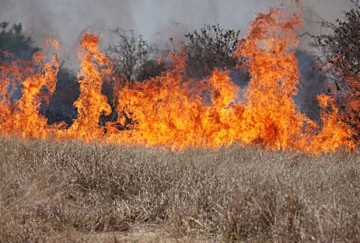
A wildfire fueled by invasive cheatgrass burns fragile sage steppe habitat.
Photo courtesy of USDA/NRCS, 2015
Invasive plants have been described as
". . . a raging biological wildfire--out of control, and spreading rapidly."
If weed management expert Steve Dewey is right about this, it's up to us, the residents of Arizona, to protect our home from the scourge of invasive plants.
With our rangelands, forests, parks, and wilderness areas, we are no strangers to wildfires, which often threaten our homes and neighborhoods. We receive frequent alerts about the current level of fire danger, and we learn and practice “firewise” strategies for protecting our property from fire.
Increasingly, land management experts tell us, we should be equally concerned about invasive plants, which pose a threat to our lands that is equal to, if not worse than wildfire.
Like wildfires, weeds have a significant economic impact. The damage they do on croplands, rangelands, wilderness and recreation areas, parks, and forests makes some of that land unusable for farming, grazing, logging, tourism, recreation, and housing, reducing the value of those lands. While some of that cost can be recouped through aggressive weed management, this too has steep costs. Researchers at Cornell have estimated the economic impact of invasive plants in the U.S. to be $120 billion a year.
Weed infestations also impair the quality of the landscape. They actually increase the frequency and intensity of wildfires! The image at the top of this page shows a wildfire fueled by a cheatgrass infestation. Invasive plants threaten our forests, farms, and recreation areas, as well as our towns and our homes. In addition, they
- reduce biological diversity by crowding out native plants
- compete with desirable plants for water and native pollinators
- replace complex plant communities with monocultures
- degrade wildlife habitat
- clog streams and encourage flooding
- increase soil erosion
- blanket trails, walkways, lots, and landscapes
The effect of weed infestations can also be more permanent than wildfire, says Steve Dewey, a weed management expert at Utah State University, “Lands affected by wildfire are self-healing, whereas lands invaded by noxious weeds don’t return naturally to their pre-invasion condition.”
What qualities do invasive plants possess that make them so harmful? What makes them “weedy”?
- abundant seed production
- highly successful rate of germination
- long-lived seed viability
- hardy, far-reaching rhizomes (spreading roots)
- ability to spread quickly via seed or roots
- aggressive growth
- ability to outcompete native plants
- toxic chemicals that suppress growth of nearby plants (allelopathy)
- tolerance for disturbed or inhospitable growing conditions
These “weedy characteristics” enable invasive plants to spread—like wildfire! A few weeds spring up, then spread to cover huge areas if not stopped quickly. “Weed seeds, like embers, can be carried long distances by wind or other means. Resulting new ‘spot’ infestations grow and merge, much like spot fires ahead of an advancing fire front,” says Dewey.
What, exactly, is an invasive plant? To learn more, click here.
References:
- Noxious weeds .... a biological wildfire, Steven A. Dewey, Utah State University
Weeds Gone Wild: Alien Plant Invaders of Natural Areas, Plant Conservation Alliance Alien Plant Working Group
